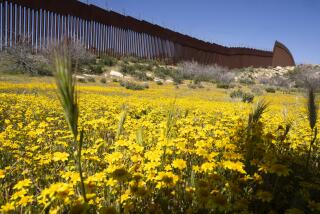Where have all the fliers gone? Ask Ike
- Share via
GILCHRIST, TEXAS — One of North America’s renowned bird migration and bird-watching areas is strangely silent.
Blame Hurricane Ike.
“We had red-winged blackbirds, sparrows, a bunch of migrating birds,” recalled Ernest Stone, 75, leaning on his cane and surveying debris on the cratered moonscape that used to be the family beach house on Bolivar Peninsula.
“I haven’t seen a pigeon in a while,” he said. “Sea gulls. You could always go out and throw a piece of bread and the sea gulls would come.”
Not now.
“Nothing,” said his wife, Jimmie. “Zero.”
The same could be said for their home and the community of Gilchrist, where little is standing three weeks after Ike roared ashore with 110-mph winds, a 12-foot storm surge and waves up to 26 feet. The few palm trees or patches of grass, nearly unrecognizable amid the shells and dried mud, have turned a lifeless yellow-brown, killed by seawater.
For people surrounded by devastation with months of rebuilding ahead, the birds represent yet another piece of normal life that’s been lost.
“Pelicans and sea gulls,” Veronica Felty, 46, said, gazing at the Gulf of Mexico waters that wiped out her place. “Birds -- 40 to 50 in a row -- flying. They were endless. They were beautiful. Pelicans so thick . . .
“You wonder if they knew to leave.”
Bolivar Peninsula is part of what’s known as the Great Texas Coastal Birding Trail, with nearby High Island a prime bird-watching spot and traditional rest stop for migrating birds heading north in the spring and south in the fall.
High Island, at 32 feet above sea level, is the highest spot on the gulf coastline for 700 miles between Mobile Bay, Ala., and the Rio Grande, and attracts thousands of bird-watchers every year.
“Now is when birds would normally be stopping at High Island to top off with bugs before heading south,” said Ian Tizard, director of the Schubot Exotic Bird Health Center at Texas A&M; University. “High Island has been stripped of leaves, and a lot of the trees are dying.”
Although the loss is tough for bird-watchers, Tizard said it might not be so bad for many of the birds: “From a migrating bird’s point of view, it’s probably not a big deal to fly a few miles on until they find a batch of trees that looks better.”
Tizard said he thought things would get better in the spring.
Just like humans, the birds need three basics that Ike took away: cover, food and water.
“There’s no fresh water,” said Texas Parks and Wildlife Department biologist Cliff Shackleford, who said a good rain would help. “That surge killed everything and dumped saltwater into everything, probably for miles.
“It doesn’t mean they all died, but we don’t really know. The birds . . . need to drink, they need to bathe, and saltwater just doesn’t do it.”
More to Read
Sign up for The Wild
We’ll help you find the best places to hike, bike and run, as well as the perfect silent spots for meditation and yoga.
You may occasionally receive promotional content from the Los Angeles Times.






